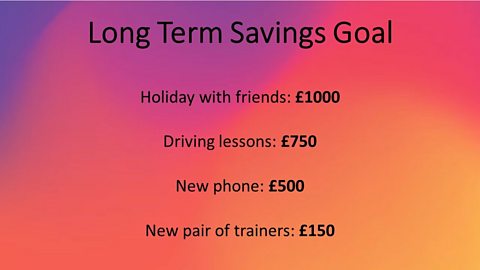The challenge
Video summary
Iona Bain is a prominent financial journalist and author who advocates for the importance of saving as a key aspect of financial planning.
Iona believes that savings should be a top priority for everyone, regardless of their income level or age. She emphasizes that saving doesn't have to be complicated, and that even small amounts can add up over time.
This is a challenge around saving towards a large long-term goal.

Challenge round-up
Iona Bain summarises the key considerations for the challenge.
Teacher notes
Watch the video and then split the class into pairs or groups to work on the task set in Part 1 of the film. After the activity time has passed re-group and watch Part 2 of the video to see how Iona would have gone about things.
Choose from a selection of activities to help students learn more about credit and debt.
Before watching
Questions to get the class thinking and talking:
- What are the benefits of saving?
- Which is best saving or getting into debt?
- What should you consider before borrowing money?
Establish that: Saving and using credit are two different approaches to managing your finances, and each has its own virtues. However, when it comes to building long-term wealth and financial stability, saving has clear advantages over relying solely on credit.
Using the film
You may wish to play the films twice: once straight through and once with pauses, to take students' comments and questions. Encourage the students to make notes as they watch.
After watching
Role-play - You are a financial educator, and the students are a group of high school students who are about to graduate and start college soon. The students are worried about how they can save money for college, manage their expenses and avoid falling into debt.
Challenge: During the role play, you should try to demonstrate your ability to:1. Engage their partners in a friendly and interactive conversation about saving, budgeting and managing expenses.2. Explain the importance of setting financial goals and creating a budget to achieve them.3. Provide practical advice on how to save money for college, including tips on reducing expenses, finding scholarships, and applying for financial aid.4. Highlight the risks of using credit cards or taking out loans without careful planning and consideration.5. Encourage the students to ask questions, share their own experiences and engage in critical thinking about their financial future.
Activity ideas
- Glossaries - Students could compile glossaries of financial terms used in the film clip, along with their own definitions. This encourages them to clarify their understanding of key vocabulary.
Terms might include: 'credit', 'debt', 'interest', 'interest rate', 'Annual Percentage Rate (APR)', 'overdraft', , 'loan'.
- APRs - Working in pairs, students could use an online loan repayment calculator to explore borrowing ôÈ100 at a range of different APRs. For each APR, they should note the length or 'term' of the loan, the monthly payment, total interest and total amount repayable. They should explore banks and ãpayday loanã options as well as online shopping options offered on websites.
Point out that, even if the APR and monthly payments seem low, when a loan runs for a long time it ends up costing a lot to borrow a little.
Invite each pair of students to draw leaflets advertising three loans from their imaginary bank. Each loan has a different APR and a different term. Their classmates must try to spot the best deal (the one that will cost them the least in the end) for borrowing ôÈ100.
- Alternatives - Ask the question 'are there alternatives to saving money?' The class could list suggestions, such as: 'wait until you've been paid, cut back on other spending, do some overtime, sell something to raise the cash, choose a cheaper item, or consider if you really need to buy something at all.'
Supported learning and SEN
Students could (with any necessary support) take a screengrab from Iona Bainãs film and add their own speech bubble, e.g., 'Access and Reward meansãÎã. A collection of 'Iona says' captures and captions could form a financial education comic strip.
Follow-up task
Ask the class to research online the differences between various savings accounts.
This short film meets and extends curriculum requirements for financial literacy at:
- Key Stage 3 and Key Stage 4 in England (Citizenship and Personal, Social, Health and Economic Education)
- Wales (Mathematical Development and Personal and Social Education)
- Northern Ireland (Mathematics and Numeracy and Learning For Life and Work)
- Third and Fourth Level and the Senior Phase in Scotland (Mathematics and Numeracy, Social Studies and Learning, Life and Work).
Where next?
University budget challenge with Cat the Vet. videoUniversity budget challenge with Cat the Vet
Vet and TikTok star Cat Henstridge (Cat The Vet ) offers tips on budgeting for university, before setting a related challenge for students.

Tax budget challenge with Cel Spellman. videoTax budget challenge with Cel Spellman
Actor and presenter Cel Spellman explains how the tax system works and sets a related tax budget challenge.

Party budget challenge with Gayle Chapman. videoParty budget challenge with Gayle Chapman
Food vlogger Gayle Chapman explains how borrowing money works, before setting students a party budget challenge.

Sticking to a budget challenge with Liam MacDevitt. videoSticking to a budget challenge with Liam MacDevitt
Former professional footballer Liam MacDevitt sets students a challenge to plan and stick to a budget ahead of a trip with friends to a football match.

Iona Bain's money jargon busters. videoIona Bain's money jargon busters
In these short videos for secondary schools Morning Live's financial expert Iona Bain clearly explains pensions, mortgages, inflation, interest rates, credit and pensions.

Financial literacy with Steph McGovern. collectionFinancial literacy with Steph McGovern
In these short films for secondary schools Steph McGovern breaks down some key areas of study for the topic of financial literacy. These four short films will provide secondary students with a good understanding of credit, debt, pensions and how interest and taxation works.
